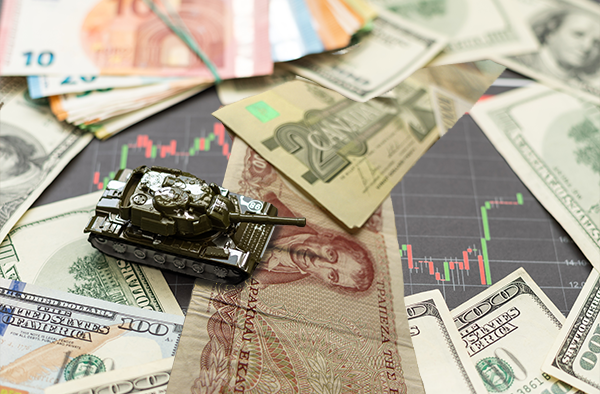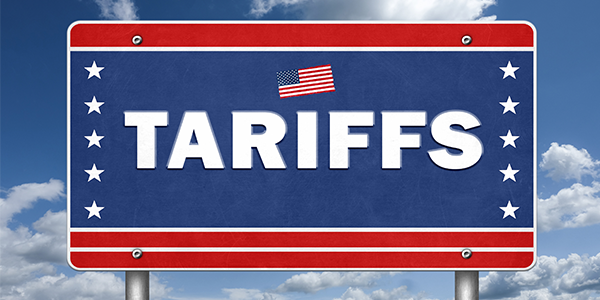

Dr. Copper Gives the Economy a Clean Bill of Health
The rally in "Dr. Copper" is due in large part to higher demand from manufacturers in the U.S., China and eurozone. The JPMorgan Global Manufacturing PMI climbed from 53.0 in October to 53.7 in November, a 33-month high.
Press Release: U.S. Global Investors Continues GROW Dividends and Share Repurchase Program
By Frank Holmes
CEO and Chief Investment Officer
U.S. Global Investors

“Dr. Copper,” so named for the metal’s ubiquitous use in many different applications, has been ripping higher since its 52-week low in March, thanks to a number of factors including promising economic data. Copper rose 12.24% in November, its best month in four years. Today it was trading as high as $3.52 per pound, or $7,679 per ton, its highest level since March 2013.
The rally is due in large part to higher demand from manufacturers in the U.S., China and eurozone. For the month of November, the IHS U.S. Manufacturing PMI hit 56.7, up significantly from 53.4 in October. The month-to-month increase was the sharpest since September 2014, according to IHS Markit.
China, the world’s largest consumer of the red metal, is forecast to be the only major economy to demonstrate growth this year, and earlier this week, the Organization for Economic Cooperation and Development (OECD) said it believes China will account for a third of all economic growth seen around the world in 2021.
Chinese factories signaled their strongest improvement in over a decade. The Caixin China General Manufacturing PMI posted 54.9 in November as output and new orders surged to 10-year highs. European factories also continued to expand, though at a slightly slower pace than the previous month.
Looking at manufacturers on a global scale, the data is just as strong. The JPMorgan Global Manufacturing PMI climbed from 53.0 in October to 53.7 in November, a 33-month high. According to JPMorgan economists, this marks the fastest pace since January 2018.
The Start of Another China-Driven Supercycle?
In light of the positive manufacturing uptrend, some economists and market experts see the start of a new copper-price supercycle driven largely by China. The Asian country currently consumes about half of all copper produced worldwide, and this activity could increase as the nation undergoes a vast energy shift to renewables such as wind and solar.
This week, a senior executive at BHP, one of the world’s top copper producers, said that copper output would need to double over the next 30 years to meet surging demand for green renewable energy.
Reflecting on the copper bull run, which has lifted the metal’s price some 72% since the March low, one money manager believes this rally could be one for the history books. Says Luke Sadrian, chief investment officer at Commodities World Capital, copper is “looking like it did in ’04 and ’05, and the world didn’t get the memo.”
Due to massive imports from China, copper prices increased more than 280% between the beginning of 2004 until they peaked in May 2006.
Today’s China imports of the red metal are much greater than they were then. In July of this year, the country bought a record 762,211 tonnes of unwrought copper, which is close to four times greater than the average monthly import amounts between 2004 and 2007.
In a note to clients this week, Goldman Sachs analysts said they believe the current price strength “is not an irrational aberration” but rather “the first leg of a structural bull market in copper.” By the first half of 2022, the Wall Street bank says that it’s “highly probable” copper could test its previous record high of nearly $10,150 per ton, set in February 2011.
Copper Miners on Fire
As a result, shares of copper producers and explorers have soared. For the six months through December 3, the Solactive Global Copper Miners Index was up more than 66%, outpacing the returns for other metal miner groups. Performance for the period was driven by companies such as Capstone Mining (up 174.04%), which operates in the U.S. and Mexico; Arizona-based Freeport-McMoRan (140.68%); and Ivanhoe Mines (93.93%), which is currently developing three properties in Southern Africa.
 |
Our favorite copper name continues to be Ivanhoe. As I reported in September, the Vancouver-based company is set to begin production at its tier-one Kamoa-Kakula Copper Project in the Democratic Republic of the Congo (DRC), believed to be the world’s second-largest copper deposit.
“Kakula is on track to begin production in under one year from now, which, considering we’ve been working in Africa for 27 years now, feels like tomorrow morning,” commented Robert Friedland, Ivanhoe’s billionaire founder and co-chairman.
Since Robert visited office in January 2018, shares of Ivanhoe have increased more than 40%. I last wrote about Ivanhoe in mid-September, and since then, the stock has returned 9.7%.
This week, Ivanhoe gave a virtual site tour of its 64%-owned Platreef Project in South Africa, which will mine for palladium, platinum, rhodium, nickel, copper and gold. The company believes Platreef is set to become on the world’s largest producing mines of platinum-group metals, with potential annual output of more than 600,000 ounces of palladium, platinum, rhodium and gold.
You can watch the tour for yourself by clicking here.
HIVE Blockchain: Record Quarterly Revenue and Cash Flow
On Monday, HIVE Blockchain Technologies reported financial results for the second quarter of fiscal 2021. Thanks to all who attended, and thanks also to everyone who helped make this past year such a success. I am proud to serve as the Interim Executive Chairman and play a key role in daily operations.
U.S. Global Investors took HIVE public in September 2017 because we wanted to give investors an opportunity to participate in cryptocurrency mining, similar to how an investor can buy Ivanhoe to get exposure to copper. (As a reminder, U.S. Global owns 10 million shares of HIVE and our stock often moves in line.)
What makes HIVE truly special is that all of the digital coins we produce are virgin, meaning they were not previously owned. That way, we don’t have to worry about anti-money laundering (AML) laws.
For the quarter ended September 30, HIVE generated a record $9.2 million in net income, compared to a loss of $11.5 million in the same period a year earlier. Adjusted EDITDA, which measures operating cash flow, was $10.6 million, a significant increase from a loss of $4.6 million last year.
HIVE trades in Canada (TSXV:HIVE), the U.S. (OTC:HVBTF) and Germany (FRA:HBF), and so far this year, trading volume has smashed last year’s numbers. As of Friday morning, more than 1.8 billion shares of HIVE had been traded around the world. That’s three times more than the 626 million shares that were traded in 2019.
Year-to-date, HIVE has smoked its crypto-mining peers. Through December 4, shares were up an incredible 1,216%, trading with the price of Ethereum about 90% of the time. Please keep in mind that the crypto industry is still in its early stages, so investing in coins and miners remains very volatile.
Mr. Gold and Mr. Wonderful Return
Many of you listened to my live conversation with Kevin O’Leary, “Mr. Wonderful” himself, chairman of O’Shares ETFs back in October.
A second discussion has been scheduled to ponder what’s ahead in 2021 and we’re now taking registrations. Among the topics Kevin and I will be covering are potential policies under President-elect Joe Biden, the post-COVID world and the implications on your portfolio.
Join us on Thursday, December 10, at 11:00 AM Eastern. Register for FREE by clicking here!
Gold Market
This week spot gold closed at $1,838.86, up $51.07 per ounce, or 2.86 percent. Gold stocks, as measured by the NYSE Arca Gold Miners Index, ended the week higher/lower by 2.89 percent. The S&P/TSX Venture Index came in up 2.66 percent. The U.S. Trade-Weighted Dollar fell 1.04 percent.
| Date | Event | Survey | Actual | Prior |
|---|---|---|---|---|
| Nov-30 | Germany CPI YoY | -0.2% | -0.3% | -0.2% |
| Nov-30 | Caixin China PMI Mfg | 53.5 | 54.9 | 53.6 |
| Dec-1 | Eurozone CPI Core YoY | 0.2% | 0.2% | 0.2% |
| Dec-1 | ISM Manufacturing | 58.0 | 57.5 | 59.3 |
| Dec-2 | ADP Employment Claims | 440k | 307k | 404k |
| Dec-3 | Initial Jobless Claims | 775k | 712k | 787k |
| Dec-4 | Change in Nonfarm Payrolls | 460k | 245k | 610k |
| Dec-4 | Durable Goods Orders | 1.3% | 1.3% | 1.3% |
| Dec-8 | Germany ZEW Survey Expectations | 46.0 | — | 39.0 |
| Dec-8 | Germany ZEW Survey Current Situation | -66.0 | — | -64.0 |
| Dec-10 | ECB Main Refinancing Rate | 0.000% | — | 0.000% |
| Dec-10 | Initial Jobless Claims | 720k | — | 712k |
| Dec-10 | CPI YoY | 1.1% | — | 1.2% |
| Dec-11 | Germany CPI YoY | — | — | -0.3% |
| Dec-11 | PPI Final Demand YoY | 0.7% | — | 0.5% |
Strengths
- The best performing precious metal for the week was platinum, up 9.59 percent on supply shortfalls and expectations that the metal will have a roll in fuel cell technologies. Platinum extended its rally to hit a four-year high of $1,048.34 an ounce. The precious metal gained nearly 14% in November, its best month since 2008 and wiping out its loss for the year. The rally is in large part due to a projected record production deficit.
- The Perth Mint reported November gold sales rose due to a significant increase in demand from international wholesale customers, particularly in Germany. Gold coin and minted bar sales totaled 84,158 ounces, the highest since April and up from 38,367 in October.
- Gold had its first weekly advance in a month after rising back above $1,800 on Tuesday and as prices steadied on Friday. Bullion rose to a one-week high on Thursday as investors weighed prospects for a vaccine and the murky outlook for U.S. stimulus negotiations, reports Bloomberg.
Weaknesses
- The worst performing precious metal for the week was palladium, down 3.13%, perhaps on some traders rotating out of palladium which seem to have lost its momentum relative to platinum. Citigroup cut its forecast for net inflows into gold ETFs to just 800 tons, 75 tons less that previously predicted, reports Bloomberg. The bank expects inflows to be 50% lower in 2020 and sees support for gold in the short term at $1,700 an ounce.
- Gold imports by India fell in November despite hopes for stronger buying during the festival of lights. Overseas purchases dropped 41% last month from a year earlier to 33.1 tons. Purchases were up from the 29 tons in October.
- The Industrial and Commercial Bank of China suspended account opening by individuals for gold and silver trading due to rising market risks and uncertainties amid precious metal price volatility. China Construction Bank did the same two days later. China is the world’s largest consumer of gold.
Opportunities
- The worst performing precious metal for the week was palladium, down 3.13%, perhaps on some traders rotating out of palladium which seem to have lost its momentum relative to platinum. Citigroup cut its forecast for net inflows into gold ETFs to just 800 tons, 75 tons less that previously predicted, reports Bloomberg. The bank expects inflows to be 50% lower in 2020 and sees support for gold in the short term at $1,700 an ounce.
- Gold imports by India fell in November despite hopes for stronger buying during the festival of lights. Overseas purchases dropped 41% last month from a year earlier to 33.1 tons. Purchases were up from the 29 tons in October.
- The Industrial and Commercial Bank of China suspended account opening by individuals for gold and silver trading due to rising market risks and uncertainties amid precious metal price volatility. China Construction Bank did the same two days later. China is the world’s largest consumer of gold.
Threats
- As bitcoin rises to new all-time highs and gold loses steam, the debate between the two assets intensifies. More and more investors are calling for bitcoin as the new haven asset to replace gold. “Gold was really the safe asset of the past world and baby boomer generation. Now it’s being replaced by automated assets like bitcoin,” said Jean-Marc Bonnefous, a former commodities hedge fund manager, in a Bloomberg interview. Gold-backed funds have dropped 93 tons of the metal since November 6, while the Grayscale Bitcoin Trust has doubled in dollar terms since the start of August.
- Gold had its biggest monthly slide in four years, down more than 5% in November. The metal has lost steam as a COVID-19 vaccine nears global approval, which is sparking hopes of an economic recovery. Bullion tends to perform well during periods of economic and geopolitical uncertainty. The question is whether investors will keep buying gold even when the economic situation improves.
- Just like gold, silver has lost love for investors. Silver ETFs had their biggest weekly outflow since 2011 in the week ended November 27. Although silver has more industrial applications than gold, it typically tracks the price of its relative, writes Bloomberg’s Eddie Spence.
Index Summary
- The major market indices finished up this week. The Dow Jones Industrial Average gained 1.03%. The S&P 500 Stock Index rose 1.67%, while the Nasdaq Composite climbed 2.12%. The Russell 2000 small capitalization index gained 2.00% this week.
- The Hang Seng Composite lost 0.69% this week; while Taiwan was up 1.91% and the KOSPI rose 3.72%.
- The 10-year Treasury bond yield rose 13 basis points to 0.97%.
Domestic Economy and Equities
Strengths
- Activity in the U.S. services sector gained momentum in November, driven by upturns in output and new business despite the surge in virus infections across the country. The final reading for the service purchasing managers’ index (PMI) for November was 58.4, up from the 56.9 reading in October and above the earlier released flash estimate of 57.7. The indicator confirmed the fourth consecutive monthly expansion in service sector business.
- New jobless claim filings last week reached their lowest level of the pandemic crisis, providing a sign that hiring is continuing if at a slower pace. First time claims for unemployment benefits totaled 712,000 last week, compared with 787,000 a week earlier and the Dow Jones estimate of 780,000.
- HollyFrontier was the best performing S&P 500 stock for the week, increasing 14.52%. The refiner disclosed plans for a big investment jump in its renewables business to $500M-$530M next year, compared with $130M-$145M in 2020.
Weaknesses
- Nonfarm payrolls increased by just 245,000 jobs in November after rising by 610,000 in October. Expectations were for an increase of 460,000 jobs. The fifth straight monthly slowdown in job gains left employment well below its February peak.
- Pending home sales fell 1.1% month-to-month in October. Analysts expected a gain of 1%. “The housing market is still hot, but we may be starting to see rising home prices hurting affordability,” Lawrence Yun, chief economist for the National Association of Realtors, said in a release.
- Salesforce.com was the worst performing S&P 500 stock for the week, falling 8.79%. Shares fell almost 10% on Wednesday after the cloud computing leader announced the acquisition of Slack Technologies for a staggering $27.7 billion in cash and stock.
Opportunities
- Paul Tudor Jones predicts an ‘absolute supersonic boom.’ The U.S. will see an explosion of growth in 2021 as the COVID-19 vaccine unleashes pent-up demand from consumers and investors, he said.
- Tesla jumps after Goldman Sachs upgrades its stock. The EV-maker’s rating was lifted to "buy" from "neutral" and its price target boosted to $780.
- DoorDash is aiming for a $127 billion IPO. The company wants to raise $2.8 billion, setting the stage for one of the biggest floats of 2020.
Threats
- Chinese automaker Kandi plunged after a scathing short-seller report. Hindenburg Research accused the company of faking sales to raise $160 million from U.S. investors.
- Stocks could pull back up to 7% before the end of 2020, according to BNY Mellon’s Liz Young.
- The FTC and state attorneys general are going after Big Tech. Four new lawsuits are intended to determine if the internet giants improperly used their power in the online marketplace.
Energy and Natural Resources Market
Strengths
- The best performing commodity for the week was lumber, up 7.23%. Despite tariff duties being cut by 50% on Canadian lumber, housing demand is still booming. Copper rallied to a seven-year high as strong global PMI data and China’s growing demand for the metal gave hope to investors of an economic recovery. The red metal is often viewed as a bellwether of the larger economy. Copper is up more than 75% from March lows. Iron futures hit a record in Singapore on Friday on the heels of copper’s gains and China’s massive demand for steel. The metal surged above $130 a ton on weaker supply from Australia and growing orders from China.
- Oil rose toward $50 a barrel on Friday morning after OPEC+ reached a deal to gradually taper production cuts and start adding 500,000 barrels a day of crude to the market in January, reports Bloomberg. Crude rose earlier in the week after a surprise drop in U.S. inventories.
- Denmark, the European Union’s largest oil producer, will stop offering new licenses in the North Sea and will phase out production by 2050, reports Bloomberg. Denmark’s government reached an agreement with parliament that will abandon all future exploration and keep around 150 million barrels of oil beneath the ocean that would have been drilled. The country hopes its historic decision to move in a fossil fuel-free direction will resonate around the world.
Weaknesses
- The worst performing commodity for the week was natural gas, down 9.81%. Natural gas for January delivery is now trading below February prices, which is a closely watched gas spread and a first for the 2021 contracts. Gas for January delivery fell 9.8% while February delivery slid 9.5%, reports Bloomberg. The heating fuel fell as weather forecasts show warmer temperatures for the coming winter, which will likely weaken demand. A government report showed that only 1 billion cubic feet of gas was taken out of storage last week, much lower than the five-year average draw of 41 billion for this time of year.
- Chevron slashed its long-term capital spending plan spends in response to this year’s crash in oil prices. The company said capital and exploratory expenditure will be $14 to $16 billion annually from 2022 to 2025, down from a previous forecast of $19 to $22 billion, reports Bloomberg. Exxon Mobil also announced a drastic reduction in capital spending this week.
- SolGold has hinted its giant copper mine in Ecuador will cost more to build than originally planned, reports Bloomberg. The miner, which is backed by BHP Group and Newcrest Mining, said it will have to redesign parts of its planned underground mine and a study on development will be delayed, sending shares down as much a 9% on the day. The Cascabel project is among the biggest undeveloped copper mines in the world.
Opportunities
- Glencore, the world’s biggest cobalt supplier, extended its supply agreement with China’s GEM Co to sell 150,000 tons of the key battery metal between 2020 and 2029. Bloomberg notes the prior agreement was for 60,000 tons through 2024. This comes as cobalt recovers and China ramps up its push for electric vehicles.
- MMC Norilsk Nickel PJSC, the world’s top palladium miner, boosted its projection for a deficit in 2020. The miner expects a shortfall of 400,000 ounces by yearend, up four times from its prior estimate. This should bode well for palladium prices.
- Ben van Beurden, CEO of Royal Dutch Shell, said he is hopeful the inauguration of Joe Biden as the new U.S. president will bring collaboration and speed up the climate change fight, reports Bloomberg. “I’m quite hopeful that with the new administration coming in, there will be a change of sentiment and hopefully a change of direction.” Van Beurden said Biden’s vow to rejoin the Paris Climate Accord is “a pretty good start.”
Threats
- California’s three biggest utilities are weighing cutting power to 1 million residents to prevent live wires from sparking fires during high winds. The state has already suffered immensely from wildfires in 2020 with 4.2 million acres burned and 31 people dead. The National Weather Service forecast high winds this week that could fan flames and knock power lines, reports Bloomberg.
- Petrobras CEO Roberto Castello Blanco said pledging to be carbon neutral by 2050 is “like a fad” and is unrealistic. In a Bloomberg interview, Blanco dismissed pledges by peers such as Shell and Occidental to completely neutralize their carbon footprints in just 30 years. The state-controlled Brazilian giant is pledging a more modest goal of a 25% cut in carbon emissions by 2030.
- Bank of Montreal (BMO) has become the latest financial institution to cut ties with America’s shale industry. The bank announced it will wind down its U.S. oil and gas investment banking business to focus on assets in Canada moving forward. It will eliminate about 50 positions in its investment banking group.
Airline Sector
Strengths
- The best performing airline for the week was Brazil’s Gol Linhas Aereas Inteligentes, operating as GOL Airlines, up 21.54%.
- Ryanair confirmed a more than $7 billion deal to buy 75 of the Boeing 737 Max jets just weeks after the aircraft was approved to fly again in the U.S. CEO Michael O’Leary emphasized his confidence in the safety of the jet and says he expects the rapid return of travel in 2021 after a vaccine is widely distributed. The deal is a strong positive signal for air travel demand.
- Airlines are now tasked with the “mission of the century” for air transport in distributing a COVID-19 vaccine to the world. The U.K. has begun use of a vaccine and the FDA is nearing approval of a vaccine for use in the United States. The U.S. Transportation Department approved safety requirements for carrying the potentially dangerous dry ice needed to keep some vaccines stable on cargo aircraft. International Air Transport Association (IATA) CEO Alexandre de Juniac said that “this will be the largest and most complex logistical exercise ever.” Over 30% of the world’s passenger aircraft is still in storage and will be a logistical challenge to both make available passenger jets for cargo trips and getting the aircraft back in use.
Weaknesses
- The worst performing airline for the week was Australia’s Qantas Airways, down 4.53%.
- American Airlines said that, after a strong start to the fourth quarter, a deceleration in net bookings growth began before Thanksgiving and has continued into December. The carrier expects its daily cash consumption to be as much as $30 million, reports Bloomberg. This follows a similar warning by Delta Air Lines that said it may burn more cash in the fourth quarter than expected due to the slowdown as COVID-19 cases rise.
- All travelers entering Canada must quarantine for 14 days—a rule that has remained unchanged since March. This lengthy quarantine and a ban on almost all foreign tourists, on top of PM Justin Trudeau’s balking at bailing out airlines, continues to hurt carriers. Bloomberg notes traffic at airport security checkpoints in Canada is just 14% of last year’s levels in the first 29 days of November, versus 37% in the U.S. Trudeau said on Tuesday he has no plans to open borders soon.
Opportunities
- Lufthansa said it will add more flights to its Christmas schedule after a surge in bookings from German tourists. The carrier will boost service to southern European destinations including Greece, Italy and Spain to meet demand, reports Bloomberg. This is rare positive news for the carrier, which took a $10.9 billion government bailout in June.
- Delta resumed nonstop flights to China, two weekly trips between Seattle and Shanghai and between Detroit and Shanghai. The routes previously included a stop in Seoul. Delta is the only U.S. carrier to have a direct flight, while other carriers continue to stop in Seoul. A direct flight is often more attractive to travelers.
- Qantas announced it will fly most of its normal domestic schedule in the first quarter after major state borders inside Australia reopen. The carrier said by June it will be generating enough cash to begin repairing its balance sheet. Airlines with a domestic focus could have the upper hand over more internationally reliant carriers.
Threats
- The Singapore-Hong Kong travel bubble has been delayed for a second time as virus cases surge. Hong Kong is facing a resurgent outbreak, prompting tighter restrictions and some international banks sending workers to stay at home. The previously announced travel bubble would have been a boon for the region’s tourism businesses seeking to start a recovery.
- Southwest announced on Thursday that 6,828 jobs were given layoff warning notices, including pilots, flight attendants, baggage handlers and others, as the carrier and its labor union have failed to agree on how to cut $500 million in costs. Bloomberg notes the new warnings boosts the number of people at risk of being cut between January and April to 7,373, or nearly 13% of the total workforce.
- The COVID-19 outbreak in the U.S. continues to intensify with several states warning they might run out of room in hospitals for ICU patients. California warned lockdowns could resume in most of the state within days. Iowa reported a second straight day of record deaths on Thursday and Pennsylvania saw a record number of daily cases. Although a vaccine nears, the virus continues to spread and further delay the air travel recovery.
Emerging Markets
Strengths
- The best performing country in emerging Europe for the week was Poland, gaining 3.8 percent. The best performing country in Asia this week was South Korea, gaining 5.3 percent.
- The Russian ruble was the best performing currency in emerging Europe this week, gaining 2.9 percent. The South Korean won was the best performing currency in Asia this week, gaining 1.8 percent.
- China’s manufacturing industry remains strong, pointing to further economic recovery. The China Manufacturing PMI, which focus on large, state-owned firms, climbed to 52.1 in November from 51.4 in October. The Caixin PMI, which tends to measure manufacturing activity in small, private companies, increased to 54.9 from 53.6 in October.
Weaknesses
- The worst performing country in emerging Europe for the week was Hungary, losing 20 basis points. The worst performing country in Asia this week was Hong Kong, losing 70 basis points.
- The Turkish lira was the worst relative performing currency in emerging Europe this week, gaining 29 basis points. The Pakistani rupee was the worst performing currency in Asia this week, losing 44 basis points.
- The crackdown on pro-democratic leaders in Hong Kong continues as China is pushing to tighten control over the territory. Three prominent Hong Kong pro-democracy activists were sentenced to prison Wednesday for a protest outside police headquarters.
Opportunities
- Mark Mobius, the founder of Mobius Capital Partners, expects emerging markets to outperform their developed counterparts in 2021. He likes India, China, South Korea, Taiwan, South Africa and Turkey. He also recommends sectors that have been hardest hit by the pandemic (cruises, travel, airlines), so long as they have strong balance sheets and access to finance.
- The European Central Bank (ECB) will meet next week on December 10, and it is likely that the bond buying program will be increased by 500 billion euros and extended by another six to 12 months. Most Bloomberg economists expect the rates to remain unchanged, with the main refinancing rate at 0.0 percent, lending rate at 25 basis points and the deposit rate at negative 50 basis points.
- Thanks to weeks of tough restrictions, many countries in Europe are planning to ease COVID-19 measures and allow Christmas shopping and gatherings. Overall, the second wave of the lockdowns in Europe appear not to have had as negative an effect on the economy as the first set of measures implemented earlier in the year did.
Threats
- Poland and Hungary continue to block the EU budget. The eurozone may decide to bypass the two veto votes and create a bridge fund which will allow the EU’s executive arm to raise jointly backed debt and distribute the funds the remaining 25 member states. If the eurozone decides to go that way, Poland and Hungary will miss out on at least 180 billion euros in aid payments from the stimulus plan, according to Bloomberg’s calculation.
- The U.S. administration approved legislation that could ultimately lead to Chinese equities getting kicked off American exchanges if U.S. regulators aren’t allowed to review their financial audits within a three year-period. The measure also requires firms to disclose whether they are under government control. Most likely both countries will be able to agree on the exact information that can be shared, avoiding this legislation resulting in delisting Chinese ADRs from U.S. exchanges.
- European Union officials said on Friday that a post-Brexit trade deal could finally be reached this weekend, but Britain sounded less optimistic. With less than four weeks left until the United Kingdom leaves the EU on December 31, the negotiations are still difficult.
Blockchain and Digital Currencies
Strengths
- Of the cryptocurrencies tracked by CoinMarketCap, the best performing for the week ended December 4 was Refereum, up 902.92%.
- Bitcoin opened the week with a new all-time high, reports CoinDesk, trading as high as $19,786.24. Long-time bitcoin investors have weathered more than one bearish market cycle, the article explains, but for newer participants, the “record highs represent validation of their investment as the cryptocurrency continues to demonstrate resilience.”
- Visa is partnering with BlockFi to offer a credit card that rewards purchases with bitcoin, rather than with airline miles or cash, writes Bloomberg. In a statement this week, BlockFi explained that users of the Bitcoin Reward Credit Card will receive 1.5% of their purchases back in bitcoin and a lump sum $250 in the crypto-asset if they spend more than $3,000 in the first three months.
Weaknesses
- Of the cryptocurrencies tracked by CoinMarketCap, the worst performing for the week ended December 4 was JSB Foundation, down 86.78%.
- Ripple used to position itself as a “regulator-friendly” cryptocurrency firm, writes CoinDesk, but the company recently threatened to leave the U.S. over regulatory uncertainty. It seems that lack of clarity from the SEC about XRP’s legal status looks to be the sticking point. However, speaking to CNN on Wednesday, CEO Brad Garlinghouse now seems to be taking the wait-and-see approach, explaining the firm hasn’t made any final decision on the matter.
- Senior market analyst at Oanda Edward Moya says that bitcoin volatility will remain high, and for now, it seems that the $20,000 level will remain a major hurdle, writes Bloomberg. Other thoughts on the popular digital currency come from Gary Cohn, a former economic chief to President Donald Trump. In an interview with Bloomberg TV, Cohn said that bitcoin “lacks some of the basic integrity of a real market.”
Opportunities
- In an effort to distance itself from the original Facebook-led vision rolled out last year, the Libra Association put together by Facebook last year is rebranding itself, writes CoinDesk. On Tuesday, the 27-member group announced it was changing its name to Diem (Latin for “day”) as it prepares for the potential 2021 launch of a single, dollar-pegged stablecoin.
- One of the largest private commercial banks in Russia, Alfa-Bank, said in a December 1 announcement that it will use blockchain-based applications to automate services for freelancers and self-employed workers, writes CoinTelegraph. Alfa-Bank has emerged as one of the most blockchain-friendly banks in Russia, the article notes.
- Bitcoin dominated the headlines in the month of November as it crept toward an all-time high, writes CoinDesk. However, one of the most prominent cryptocurrencies, XRP – the payments token used in Ripple’s global payments network, quietly jumped 169% during the month. XRP topped the performance rankings among digital assets in the CoinDesk2020.
Threats
- The U.S. Department of Justice and the Southern District of New York have extradited from Panama a leader of alleged Ponzi scheme AirBit Club, writes CoinTelegraph. Allegedly, AirBit Club sold “memberships” that promised guaranteed returns with the six operators marketing their returns as being the product of the club’s mining operations and trading strategies. Per the DOJ, however, those operations do not exist.
- Gold might be threatened as the go-to haven asset, as bitcoin hits new highs this week, reports Bloomberg. In fact, as bitcoin makes huge moves, billions of institutional dollars have fled gold. Coincidence or not, this could be the start of a rotation that would have a profound impact on crypto as well as the precious metals market. Now the question is, which do you prefer?
- RAKIB, the Russian cryptocurrency and blockchain association, sent a letter to Bank of Russia Chairwoman Elvira Nabiullina warnings that the potential design for the “digital ruble” will return the Russian economy to the Soviet model, when all financial activities were managed in a centralized way, reports CoinDesk. The associated warms against too much centralization of the ruble coin, as cryptocurrency generally favors decentralization.
Leaders and Laggards
| Index | Close | Weekly Change($) |
Weekly Change(%) |
|---|---|---|---|
| 10-Yr Treasury Bond | 0.97 | +0.13 | +15.61% |
| Oil Futures | 46.13 | +0.60 | +1.32% |
| Hang Seng Composite Index | 4,197.38 | -28.98 | -0.69% |
| S&P Basic Materials | 449.70 | +0.17 | +0.04% |
| Korean KOSPI Index | 2,731.45 | +98.00 | +3.72% |
| S&P Energy | 302.94 | +12.95 | +4.47% |
| Nasdaq | 12,464.23 | +258.38 | +2.12% |
| DJIA | 30,218.26 | +307.89 | +1.03% |
| Russell 2000 | 1,892.45 | +37.18 | +2.00% |
| S&P 500 | 3,699.12 | +60.77 | +1.67% |
| Gold Futures | 1,841.20 | +53.10 | +2.97% |
| XAU | 139.34 | +5.58 | +4.17% |
| S&P/TSX VENTURE COMP IDX | 769.11 | +19.91 | +2.66% |
| S&P/TSX Global Gold Index | 312.42 | +4.30 | +1.40% |
| Natural Gas Futures | 2.55 | -0.29 | -10.20% |
| Index | Close | Monthly Change($) |
Monthly Change(%) |
|---|---|---|---|
| Korean KOSPI Index | 2,731.45 | +374.13 | +15.87% |
| 10-Yr Treasury Bond | 0.97 | +0.21 | +26.80% |
| Gold Futures | 1,841.20 | -61.90 | -3.25% |
| S&P Basic Materials | 449.70 | +39.87 | +9.73% |
| S&P 500 | 3,699.12 | +255.68 | +7.43% |
| DJIA | 30,218.26 | +2,370.60 | +8.51% |
| Nasdaq | 12,464.23 | +873.45 | +7.54% |
| Oil Futures | 46.13 | +6.98 | +17.83% |
| Hang Seng Composite Index | 4,197.38 | +243.14 | +6.15% |
| S&P/TSX Global Gold Index | 312.42 | -41.19 | -11.65% |
| XAU | 139.34 | -4.06 | -2.83% |
| Russell 2000 | 1,892.45 | +277.37 | +17.17% |
| S&P Energy | 302.94 | +79.49 | +35.57% |
| S&P/TSX VENTURE COMP IDX | 769.11 | +72.80 | +10.46% |
| Natural Gas Futures | 2.55 | -0.49 | -16.19% |
| Index | Close | Quarterly Change($) |
Quarterly Change(%) |
|---|---|---|---|
| XAU | 139.34 | -11.59 | -7.68% |
| S&P/TSX Global Gold Index | 312.42 | -66.10 | -17.46% |
| Gold Futures | 1,841.20 | -104.00 | -5.35% |
| DJIA | 30,218.26 | +1,925.53 | +6.81% |
| S&P 500 | 3,699.12 | +244.06 | +7.06% |
| Nasdaq | 12,464.23 | +1,006.13 | +8.78% |
| Korean KOSPI Index | 2,731.45 | +335.55 | +14.01% |
| Natural Gas Futures | 2.55 | +0.07 | +2.65% |
| S&P Basic Materials | 449.70 | +45.38 | +11.22% |
| Russell 2000 | 1,892.45 | +347.77 | +22.51% |
| Oil Futures | 46.13 | +4.76 | +11.51% |
| Hang Seng Composite Index | 4,197.38 | +296.35 | +7.60% |
| S&P/TSX VENTURE COMP IDX | 769.11 | +38.76 | +5.31% |
| S&P Energy | 302.94 | +41.76 | +15.99% |
| 10-Yr Treasury Bond | 0.97 | +0.33 | +52.52% |
U.S. Global Investors, Inc. is an investment adviser registered with the Securities and Exchange Commission ("SEC"). This does not mean that we are sponsored, recommended, or approved by the SEC, or that our abilities or qualifications in any respect have been passed upon by the SEC or any officer of the SEC.
This commentary should not be considered a solicitation or offering of any investment product.
Certain materials in this commentary may contain dated information. The information provided was current at the time of publication.
Some links above may be directed to third-party websites. U.S. Global Investors does not endorse all information supplied by these websites and is not responsible for their content.
Holdings may change daily. Holdings are reported as of the most recent quarter-end. The following securities mentioned in the article were held by one or more accounts managed by U.S. Global Investors as of (09/30/2020):
Ivanhoe Mines Ltd.
Centamin Plc
MMC Norilsk Nickel PJSC
BHP Group Ltd
Ryanair Holdings Plc
American Airlines Group Inc
Delta Air Lines Inc
Deutsche Lufthansa AG
Qantas Airways Ltd
Southwest Airlines Co
Tesla Inc
*The above-mentioned indices are not total returns. These returns reflect simple appreciation only and do not reflect dividend reinvestment. The Dow Jones Industrial Average is a price-weighted average of 30 blue chip stocks that are generally leaders in their industry. The S&P 500 Stock Index is a widely recognized capitalization-weighted index of 500 common stock prices in U.S. companies. The Nasdaq Composite Index is a capitalization-weighted index of all Nasdaq National Market and SmallCap stocks. The Russell 2000 Index® is a U.S. equity index measuring the performance of the 2,000 smallest companies in the Russell 3000®, a widely recognized small-cap index. The Hang Seng Composite Index is a market capitalization-weighted index that comprises the top 200 companies listed on Stock Exchange of Hong Kong, based on average market cap for the 12 months. The Taiwan Stock Exchange Index is a capitalization-weighted index of all listed common shares traded on the Taiwan Stock Exchange. The Korea Stock Price Index is a capitalization-weighted index of all common shares and preferred shares on the Korean Stock Exchanges. The Philadelphia Stock Exchange Gold and Silver Index (XAU) is a capitalization-weighted index that includes the leading companies involved in the mining of gold and silver. The U.S. Trade Weighted Dollar Index provides a general indication of the international value of the U.S. dollar. The S&P/TSX Canadian Gold Capped Sector Index is a modified capitalization-weighted index, whose equity weights are capped 25 percent and index constituents are derived from a subset stock pool of S&P/TSX Composite Index stocks. The S&P 500 Energy Index is a capitalization-weighted index that tracks the companies in the energy sector as a subset of the S&P 500. The S&P 500 Materials Index is a capitalization-weighted index that tracks the companies in the material sector as a subset of the S&P 500. The S&P 500 Financials Index is a capitalization-weighted index. The index was developed with a base level of 10 for the 1941-43 base period. The S&P 500 Industrials Index is a Materials Index is a capitalization-weighted index that tracks the companies in the industrial sector as a subset of the S&P 500. The S&P 500 Consumer Discretionary Index is a capitalization-weighted index that tracks the companies in the consumer discretionary sector as a subset of the S&P 500. The S&P 500 Information Technology Index is a capitalization-weighted index that tracks the companies in the information technology sector as a subset of the S&P 500. The S&P 500 Consumer Staples Index is a Materials Index is a capitalization-weighted index that tracks the companies in the consumer staples sector as a subset of the S&P 500. The S&P 500 Utilities Index is a capitalization-weighted index that tracks the companies in the utilities sector as a subset of the S&P 500. The S&P 500 Healthcare Index is a capitalization-weighted index that tracks the companies in the healthcare sector as a subset of the S&P 500. The S&P 500 Telecom Index is a Materials Index is a capitalization-weighted index that tracks the companies in the telecom sector as a subset of the S&P 500. The NYSE Arca Gold Miners Index is a modified market capitalization weighted index comprised of publicly traded companies involved primarily in the mining for gold and silver. The Consumer Price Index (CPI) is one of the most widely recognized price measures for tracking the price of a market basket of goods and services purchased by individuals. The weights of components are based on consumer spending patterns. The Purchasing Manager’s Index is an indicator of the economic health of the manufacturing sector. The PMI index is based on five major indicators: new orders, inventory levels, production, supplier deliveries and the employment environment. The S&P/TSX Venture Composite Index is a broad market indicator for the Canadian venture capital market. The index is market capitalization weighted and, at its inception, included 531 companies. A quarterly revision process is used to remove companies that comprise less than 0.05% of the weight of the index, and add companies whose weight, when included, will be greater than 0.05% of the index. Gross domestic product (GDP) is the monetary value of all the finished goods and services produced within a country’s borders in a specific time period, though GDP is usually calculated on an annual basis. It includes all of private and public consumption, government outlays, investments and exports less imports that occur within a defined territory.
The Solactive Global Copper Miners Index includes international companies active in exploration, mining and/or refining of copper. The index includes a minimum of 20 and a maximum of 40 members. The S&P Metals & Mining Select Industry Index comprises stocks in the S&P Total Market Index that are classified in the GICS metals & mining sub-industry. The S&P/TSX Global Mining Index provides investors with a benchmark for global mining portfolios and a basis for innovative, index-linked investment vehicles. Adjusted EBITDA (earnings before interest, taxes, depreciation, and amortization) is a measure computed for a company that takes its earnings and adds back interest expenses, taxes, and depreciation charges, plus other adjustments to the metric. The CNN Fear & Greed Index is calculated by looking at seven equal-weighted indicators: the S&P 500 versus its 125-day moving average, the number of stocks hitting 52-week highs and lows on the NYSE, the volume of shares trading in stocks on the rise versus those declining, the put/call ratio, the spread between yields on investment grade bonds and junk bonds, the VIX and the difference in returns for stocks versus Treasuries. The index looks at each of the seven indicators on a scale from 0 – 100. The higher the reading, the greedier investors are being, and 50 is neutral.













































